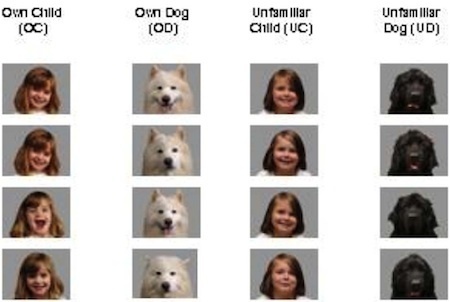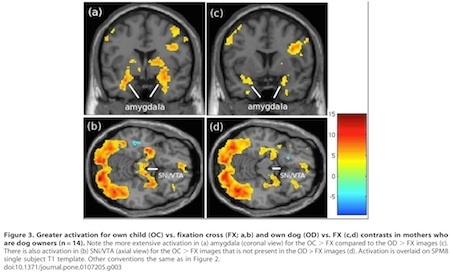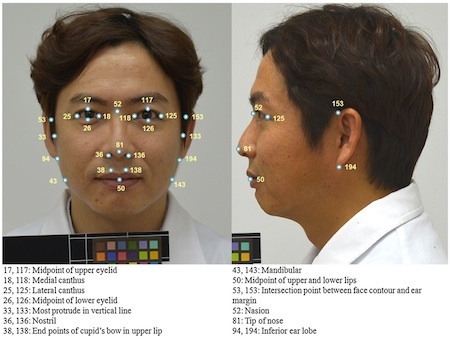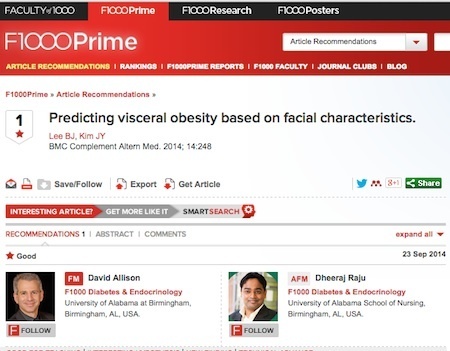Marc Abrahams's Blog, page 371
October 6, 2014
Riding the Incongruity Wave (30+ years of brainwave research)
Try reading the following sentences : ”He took a sip from the transmitter.” – “I take coffee with cream and dog.” – “He planted string beans in his car.” Did you experience anything unusual? Probably not, but if you had been hooked up to a set of scalp-electrodes and an electroencephalographic analyser which was recording the electrical activity of your brain, the system might well have logged an N400 event.
The N400 wave (so-called because it’s a negative-going pulse which appears around 400ms after the stimulus) was first described in a 1980 paper for the flagship journal Science : Kutas, M., & Hillyard, S. A. (1980). Reading senseless sentences: Brain potentials reflect semantic incongruity. Lab-based investigations had demonstrated that when experimental subjects read an ‘incongruous’ sentence like the examples above the enigmatic N400 signal consistently showed up.
Lab-based investigations had demonstrated that when experimental subjects read an ‘incongruous’ sentence like the examples above the enigmatic N400 signal consistently showed up.
Since its discovery, a swathe of scientific papers (more than a thousand in fact) have attempted to refine, understand, and utilize what some researchers have dubbed the “Incongruity Wave” – in a host of imaginative ways.
As a recent example, see this 2011 paper, from a joint Spanish/German research group which attempted to quantify the ‘counterintuitiveness’ levels in various sentences that were either deemed ‘religious’ in nature, or not. The team showed various sets of sentences to experimental participants, e.g.
[Counterintuitive religious] “From his beard came out asteroids.”
[Counterintuitive non-religious] “From his beard came out wardrobes.”
[Intuitive] “From his beard came out gray hairs.”
The N400 data from the experiments showed, say the investigators, that : “… religious ideas appear as less semantically anomalous for the human cognitive system than other types of world-knowledge violations.”
Intriguing though the results might be, readers should bear in mind that the exact nature of the N400 and any possible implications it might or might not have are still quite a way from being fully understood.
Note: The graph shown above, from the original 1980 paper, displays the N400 as an upward rising peak following the sentence “He spread the warm bread with socks.” Unusually perhaps for a graph depicting electrical activity, the Y axis shows negative voltage swings above the zero line rather than below.
Further reading :
Laughter and electroencephalographic activity* and
Humor appreciation as an adaptive esthetic emotion

October 5, 2014
Dogs ‘n kids ‘n brain-related pictures
Maybe dogs and kids are a key, arriving at last, to understanding how the brain thinks thoughts and feels emotions. Maybe.
It’s still essentially a mystery how the brain (which has been called “the most complex object in the universe“) does most of what it does. The mystery is especially deep about how — specifically — thoughts and emotions work. The advent of MRI machines has made it possible to collect lots of highly detailed images that correspond — indirectly — to chemical and electromagnetic activity in the brain. Nobody understands (except sometimes, in vague, general ways) what, if anything, most of those details explain about how the brain is doing its important doings.
A new collection of images shows indications of electromagnetochemical activity in the brains of 14 mothers while those mothers watched pictures of dogs and kids. These images are discussed in the study:
“Patterns of Brain Activation when Mothers View Their Own Child and Dog: An fMRI Study,” Luke E. Stoeckel, Lori S. Palley, Randy L. Gollub, Steven M. Niemi, Anne Eden Evins, PLoS ONE, 9(10): e107205.
The authors, at Massachusetts General Hospital and Harvard University, explain:
“We examined fMRI brain activation patterns as mothers viewed images of their own child and dog and an unfamiliar child and dog….
“SUMMARY AND CONCLUSIONS: … These results demonstrate that the mother-child and mother-dog bond share aspects of emotional experience and patterns of brain function, but there are also brain-behavior differences”
Further details from the study:
BONUS: “What we can do and what we cannot do with fMRI“

2014 Ig Nobel Prize Winners added to sortable database
The sortable database of Ig Nobel Prize Winners now includes data from all 24 years of prizes, including the recently announced 2014 prizes.
The information lives on the Silk data publishing platform, and helped us determine that we have awarded Ig Nobel Prizes in exactly 50 categories. It also helped University Ranking Watch compare the top 10 Ig Nobel producing countries with the Top 10 QS Ranking countries. And it helped at least one person create a list of every Ig Nobel Prize that has contained the word “beer” or “sex” in its citation.
Perhaps this database will reveal even more exciting correlations, or perhaps even causations.
Number of Ig® Nobel Prize Winners in each Category (click the Explore button)
Data from ig-nobel.silk.co
If you can measure it, it must be important: Ear lobe vs ear lobe vs body fat
If you can measure it, it must be important — a principle demonstrated in this study:
“Predicting visceral obesity based on facial characteristics,” Bum Ju Lee and Jong Yeol Kim, BMC Complementary and Alternative Medicine, 2014, 14:248. The authors, at the Korea Institute of Oriental Medicine, report:
No studies on the best predictor of visceral obesity based on facial characteristics have been reported. The aims of the present study were to investigate the association of visceral obesity with facial characteristics…
[The distance between both inferior ear lobes] was the best indicator of the normal and viscerally obese subjects in the following groups: Men-18-50, Men-50-80, and Women-18-50. In contrast, [mandibular width] was the strongest predictor in Women-50-80.
Here’s detail from the study
There’s further indication that this article must be important: It is currently ranked #1 in the F1000 Prime article recommendations list:

Imperfect Potato Problems
Two items to add to your imperfect potato collection:
First, an influential (it has been cited in one other study) study, in a singular writing style:
“Possible Mechanisms of Human Teratogenesis by Imperfect Potato,” Isabel Gal, Humangenetik, vol. 19, no. 3-4, 1973, pp. 311-314. Here is an imperfect potato extract:
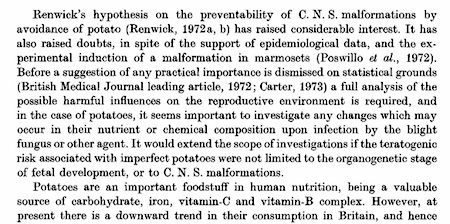
Second, an admission, by Dean Burnett, writing in The Guardian:
Lonely potato syndrome: how I invented a mental disorder
It’s possible to create a psychological condition accidentally – one that apparently spreads. No wonder getting people to appreciate the severity of genuine mental illness is such an uphill struggle…
So when asked if I had any weird habits or quirks, I said “I don’t like cooking a single jacket potato as I think it looks lonely.”
They really liked this, and wanted to explore it further. It ended with their filming me traipsing around a market, buying two of every vegetable due to my “condition” and talking to people about it (ie just making stuff up).
I’m not proud of this; it felt dangerously close to pretending to have a psychological problem. My “section” never made the final cut, for which I was very grateful, but that’s not the point of the anecdote.
When the director spoke to me, he confessed that he had this problem too. Several of the crew said the same. A producer mentioned speaking to people in the office and yes, it was quite a common anxiety people had.
This would all be fine, if it weren’t for one important fact: I MADE IT UP!

October 4, 2014
“Indians Also Lead in Improbable Research”
V Sudarshan writes in the October 5, 2014 issue of The New Indian Express:
Indians Also Lead in Improbable ResearchSome of you might be wondering if Indians have been completely ignored by the Ig Nobel committee and if Indians consequently are as under-represented in the Ig Nobel prize as they are in the Nobel prize, where you can count them all in the fingers of both your hands. I hasten to assure you that is not the case. Indians are out there in the frontiers of esoteric science, keeping abreast with those who are studying if humans swim faster in syrup or water, what odours do frogs give off when they are feeling stressed, whether it is safe to eat food that is dropped on the floor, chemically investigating bronze statues that fail to attract pigeons… The Indian flag thus waves proudly at the Ig Nobel prize ceremonies (even though some of them may not be Indian passport holders, their names sound pretty Indian).
Here is the readout of our tally:
PM Atal Bihari Vajpayee shared the 1998 prize with his Pakistani counterpart Nawaz Sharif for “aggressively peaceful explosions of the atom bomb”. (Eight years earlier, the peace prize had gone to Edward Teller, the father of the hydrogen bomb and the first champion of the Star Wars weapons system for his lifelong efforts to change the meaning of peace as we know it.)
In 2001, the Public Health Ig Nobel went to Chittaranjan Andrade and B S Srihari of the National Institute of Mental Health and Neurosciences, Bangalore, for their medical discovery that nose-picking is a common activity among adolescents.
The next year, Indians K P Sreekumar and late G Nirmalan of Kerala Agricultural University were honoured with the Mathematics prize when they came up with their report, “Estimation of the total surface area in Indian Elephants.” This was published in 1990 in the journal Veterinary Research Communications Vol 14, pages 5-17. Readers of our Kerala editions will be delighted to note that Sreekumar is the first Malayali to have won this prestigious prize. I honestly thought that the medical prize of the previous year which went for an “impactful report” on “injuries due to falling coconuts” would be of Kerala origin as well, but regretfully no. (It went to Peter Bars of McGill University.)
One of the awardees of the Physics prize of 2004 was Ramesh Balasubramaniam of the University of Ottawa (and Michael Turvey of the University of Connecticut), for explaining the dynamics of hula-hooping. Last heard, they were looking into the dynamics of hula-hooping while swallowing live goldfish.
In 2005, Gauri Nanda of Massachusetts Institute of Technology won the Economics Ig Nobel for inventing an alarm clock that runs away and hides repeatedly, thus ensuring that people do get out of bed, and thus theoretically adding many more productive hours to the workday. I believe some of her innovative designs involve computers that work by falling to the floor or after being ripped apart.
The 2008 medicine prize was shared by four people—Dan Ariely of Duke University, Rebecca Waber of MIT, Ziv Carmon of INSEAD, Singapore, and Baba Shiv of Stanford. They demonstrated that high-priced fake medicines are more effective than low-priced fake medicines in a paper under the heading: Commercial Features of Placebo and Therapeutic Efficacy. Further checking on Baba Shiv showed he held a BE (1983) from the College of Engineering, Guindy, in Chennai, and an MBA from the Indian Institute of Management, Ahmedabad. I am out of space again.
NOTE: Had V Sudarshan not run out of space again, the article would also have included several other Indian winners of Ig Nobel Prizes:
Naren Ramakrishnan , who shared this year’s Ig Nobel Prize for Public Health, for investigating whether it is mentally hazardous for a human being to own a cat.
Sonal Saraiya , who shared this year’s Ig Nobel Prize for Medicine, for treating “uncontrollable” nosebleeds, using the method of nasal-packing-with-strips-of-cured-pork.
L. Mahadevan, who shared the 2007 Ig Nobel Prize for physics, for studying how sheets become wrinkled.
Deepak Chopra , who was awarded the 1998 Ig Nobel Prize for physics, for his unique interpretation of quantum physics as it applies to life, liberty, and the pursuit of economic happiness.
Ravi Batra , economist and best-selling author of the books “The Great Depression of 1990″ ($17.95) and “Surviving the Great Depression of 1990″ ($18.95), who was awarded the 1993 Ig Nobel Prize for economics, for selling enough copies of his books to single-handedly prevent worldwide economic collapse.
BONUS: A September 19, 2014 BBC News Report: “Two Indians win Ig Nobel awards“

They grew vaginas, they’re growing penises
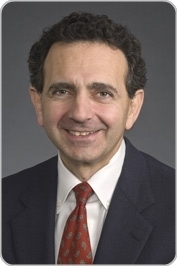 Anthony Atala and colleagues at the Wake Forest Institute for Regenerative Medicine are busy making replacement parts.
Anthony Atala and colleagues at the Wake Forest Institute for Regenerative Medicine are busy making replacement parts.
Their study “Tissue-engineered autologous vaginal organs in patients: a pilot cohort study” in The Lancet, published this year, tells of the distaff part of the story.
A report in The Guardian tells of their efforts to build masculinature: “The lab-grown penis: approaching a medical milestone“.
They are regenerating organs of regeneration.
The are also growing replacement anal sphincters — and other basic components of the human body, too.

Ig-winning pigeon-repellant researcher Hirose researches Ig-winning luak coffee
The Tribune reports [in Indonesian, here auto-translated somewhat confusingly into English]:
Examining Indonesia Japanese Coffee Wins Ig Nobel PrizeThis incident is not unusual.Coffee from Indonesia studied, the Japanese can even particularly Ig Nobel Prize, the Nobel Prize or award given as the Nobel laureate considered to make people laugh, and then make further thinking.
Unusual awards, awards to the outstanding power of the imagination to inventors in science, medical and technology. Centered in the United States.
Yukio Hirose of Kanazawa University professor who had received the Ig Nobel prize in 2003, conducting research on coffee from Indonesia, coffee roasting to capture a large amount of hydrogen in the coffee beans, and make a health drink.
Now starting October Indonesian coffee drinks began to be marketed in Fukui.
“I want to spread this health drink from the Hokuriku region,” he explained to the Fukui Shimbun, Saturday (10/04/2014).
Hirose also has served as Vice Chairman of the Japan Society Coffee Culture. Attention to water hydrogen it is that there are health effects as a new possibility for coffee. The device is placed in the vapor of hydrogen and he began his research 11 years, is heated baking. Currently he has mem-patent-right of the research results.
According to Mr. Hirose, a balance of acidity and bitterness of coffee, and sweet rose with hydrogen began to dissolve in coffee, so easy to drink. While the coffee beans with the influence of hydrogen capable of making it almost does not deteriorate seed, be it fresh longer.
Raw materials from Indonesian beans, called “hydrogen coffee”. Sales of full scale in Japan starting from June. Handled in the cafe Cosmopolitan. The price of 100 grams of coffee beans that have been dihydrogen it is 1,500 yen, the selling price for the 6 pockets is 1,080 yen.
That news item involves two Ig Nobel Prizes:
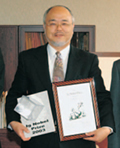 The 1995 Ig Nobel Prize for nutrition was awarded to John Martinez of J. Martinez & Company in Atlanta, Georgia, for educating the world about Luak Coffee, the world’s most expensive coffee, which is made from coffee beans ingested and excreted by the luak (aka, the palm civet), a bobcat-like animal native to Indonesia.
The 1995 Ig Nobel Prize for nutrition was awarded to John Martinez of J. Martinez & Company in Atlanta, Georgia, for educating the world about Luak Coffee, the world’s most expensive coffee, which is made from coffee beans ingested and excreted by the luak (aka, the palm civet), a bobcat-like animal native to Indonesia.
The 2003 Ig Nobel Prize for chemistry was awarded to Yukio Hirose [pictured here, holding both his Ig Nobel Prize and his certificate stating that he has been awarded an Ig Nobel Prize] of Kanazawa University, for his chemical investigation of a bronze statue, in the city of Kanazawa, that fails to attract pigeons.
BONUS (related): “New Method Checks Authenticity of Kopi Luwak Coffee“, news report, 2013.

Turgid and Obscure Language, from Roger Bolas
Turgid and obscure language impinges on the realm of medical ethics, apparently:
“Turgid and Obscure Language,” Roger Bolas, Journal of Medical Ethics, vol. 2, 1976, p 151. The author writes:
SIR,
My reactions on reading ‘obverted contrapositive’ and ‘presuppositionless characterization’ (page 103, volume 2, number 2), were to sigh deeply and to reach for the dictionary…. Many readers of your journal read selectively, browsing from time to time among the less familiar articles. Is there not a danger of them becoming discouraged if faced with turgid and obscure language? Dialogue between professional people can also be meaningful if we employ simple English.
ROGER BOLAS
Newcastle upon Tyne

October 3, 2014
Marty Perl is gone
Reports bring the sad news that Marty Perl died.
Here’s a look back a decade and a half. This is the beginning of Lila Guterman’s 1998 article in the Stanford Report about one of Marty’s smallest improbable adventures:
A paper airplane whizzed through the air and hit Stanford Nobel laureate Martin Perl in the head before he answered the first question in an interview Wednesday evening, April 8. He and fellow SLAC Nobelist Richard Taylor were grilled about chewing gum in front of an audience of 200 people in Stanford’s Terman Auditorium.
Their interviewer was Marc Abrahams, editor of the irreverent science magazine The Annals of Improbable Research. Abrahams was at Stanford to promote the new book, The Best of Annals of Improbable Research. The result was an evening of silly science.
Abrahams chomped on gum as they discussed the lofty topic, and he offered the two Nobelists their own sticks.
“How often do you chew gum?” Abrahams asked them.
“Whenever I get a bad idea,” said Perl, munching away.
“Same,” responded Taylor. “Never.”
The airplane-throwing audience laughed upon learning that Perl uses gum to stick his telephone to his desk and to plug vacuum leaks. But Taylor adamantly denied using chewing gum. “I’m more used to bubble gum,” he said….
This photo shows the three of us that night. Marty Perl is at right, examining his gum. Dick Taylor, who insisted on being identified as “Laureate X”, is the one in the middle with his face obscured.
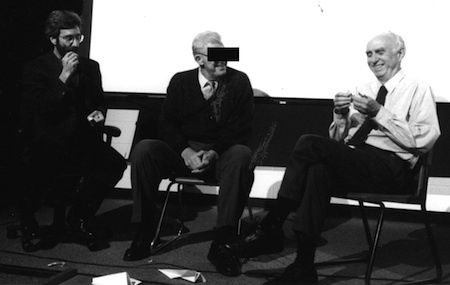
BONUS: It’s now 2014, and chewing gum is again of heightened interest to the research community.

Marc Abrahams's Blog
- Marc Abrahams's profile
- 14 followers


